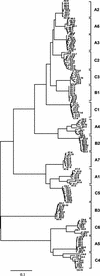Impact of highly active antiretroviral therapy and immunologic status on hepatitis C virus quasispecies diversity in human immunodeficiency virus/hepatitis C virus-coinfected patients
- PMID: 12525628
- PMCID: PMC140862
- DOI: 10.1128/jvi.77.3.1940-1950.2003
Impact of highly active antiretroviral therapy and immunologic status on hepatitis C virus quasispecies diversity in human immunodeficiency virus/hepatitis C virus-coinfected patients
Abstract
This study analyzes the effect of highly active antiretroviral therapy (HAART), and thus immunologic status, on hepatitis C virus (HCV) load and quasispecies diversity in patients coinfected with the human immunodeficiency virus (HIV) and HCV. Three cohorts of coinfected patients were analyzed retrospectively over a period of 7 to 10 months: group A was antiretroviral drug naïve at baseline and then on HAART for the remainder of the study, group B did not receive antiretroviral therapy at any point, and group C was on HAART for the entire study. HCV quasispecies diversity was analyzed by sequencing hypervariable region 1. In a longitudinal analysis, there was no significant change from baseline in any immunologic, virologic, or quasispecies parameter in any of the three groups. However, in comparison to groups A and B, group C had significantly higher CD4+- and CD8+-cell counts, a trend toward a higher HCV load, and significantly increased number of HCV clones, entropy, genetic distance, and ratio of nonsynonymous substitutions per nonsynonymous site to synonymous substitutions per synonymous site (Ka/Ks). In addition, CD4+-cell count was positively correlated with HCV load, genetic distance, and Ka. Interestingly, patients infected with HCV genotype 2 or 3 had a significantly higher CD4+-cell count, HCV load, genetic distance, and Ka/Ks than those infected with genotype 1. These results suggest that there is no immediate effect of HAART on HCV but that, with prolonged HAART, immune restoration results in an increase in HCV load and quasispecies diversity.
Figures


References
-
- Berger, A., M. von Depka Prondzinski, H. W. Doerr, H. Rabenau, and B. Weber. 1996. Hepatitis C plasma viral load is associated with HCV genotype but not with HIV coinfection. J. Med. Virol. 48:339-343. - PubMed
-
- Booth, J. C., U. Kumar, D. Webster, J. Montajardino, and H. C. Thomas. 1998. Comparison of the rate of sequence variation in the hypervariable region of E2/NS1 region of hepatitis C virus in normal and hypogammaglobulinemic patients. Hepatology 27:223-227. - PubMed
-
- Bruno, R., P. Sacchi, and G. Filice. 2001. Hepatitis C virus dynamics during antiretroviral therapy. Blood 97:3318.. - PubMed
-
- Daar, E. S., H. Lynn, S. Donfield, E. Gomperts, M. W. Hilgartner, W. K. Hoots, D. Chernoff, S. Arkin, W.-Y. Wong, C. A. Winkler, and the Hemophilia Growth and Development Study. 2001. Relation between HIV-1 and hepatitis C viral load in patients with hemophilia. J. Acquir. Immune Defic. Syndr. 26:466-472. - PubMed
-
- Daar, E. S., H. Lynn, S. Donfield, E. Gomperts, S. J. O'Brien, M. W. Hilgartner, W. K. Hoots, D. Chernoff, S. Arkin, W.-Y. Wong, C. A. Winkler, and the Hemophilia Growth and Development Study. 2001. Hepatitis C virus load is associated with human immunodeficiency virus type 1 disease progression in hemophiliacs. J. Infect. Dis. 183:589-595. - PubMed
Publication types
MeSH terms
Substances
LinkOut - more resources
Full Text Sources
Medical
Molecular Biology Databases
Research Materials

